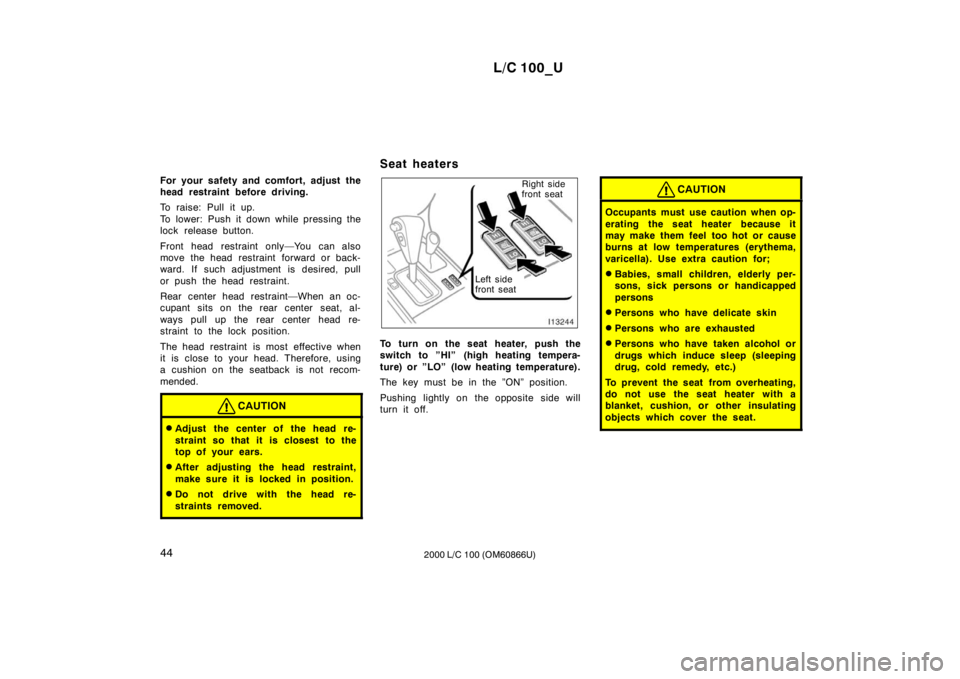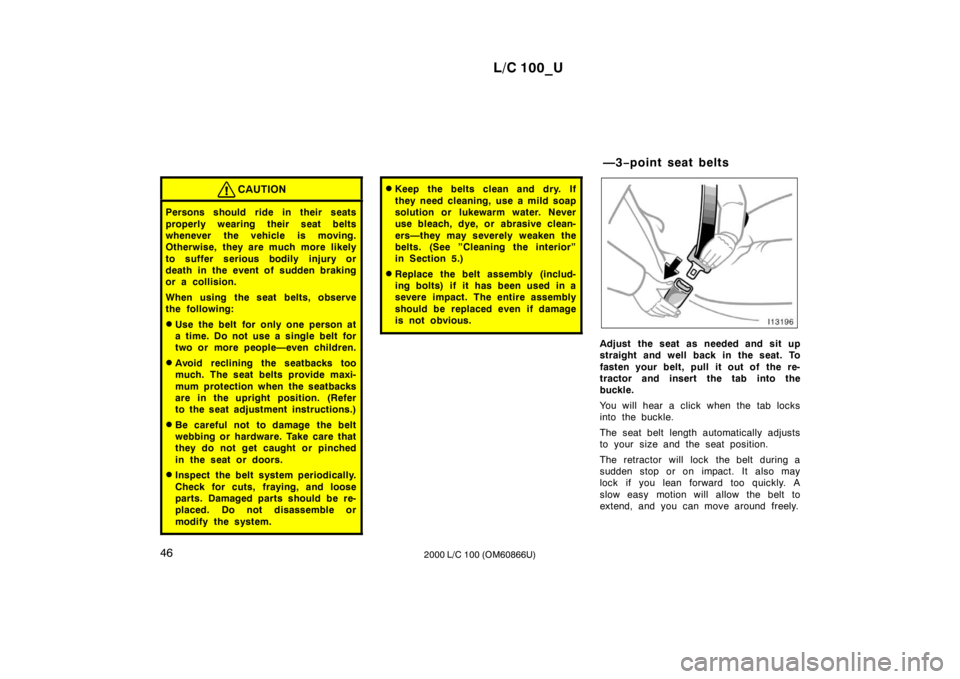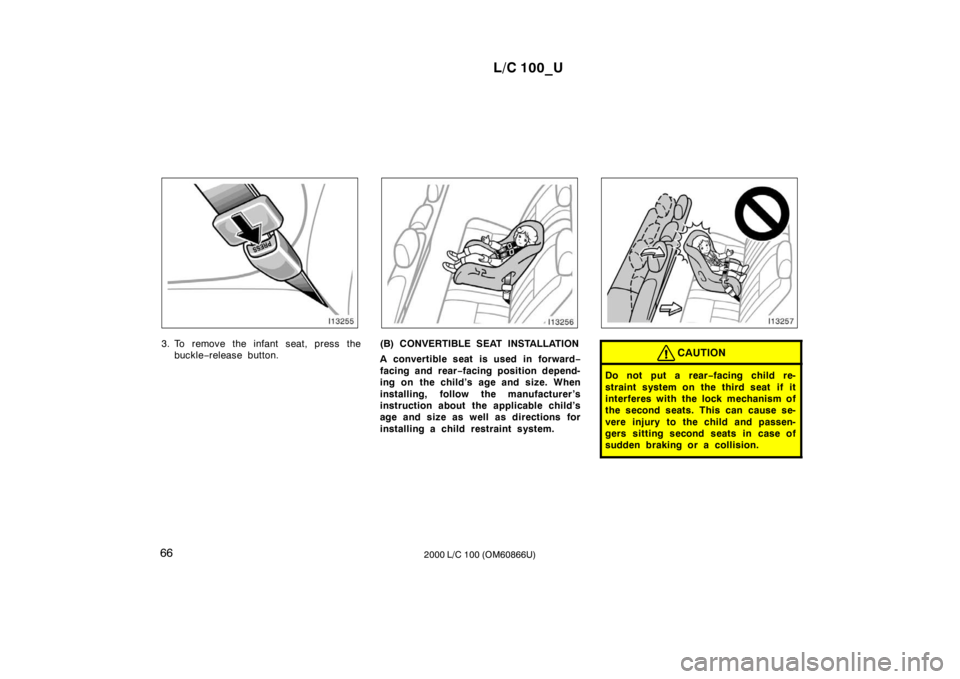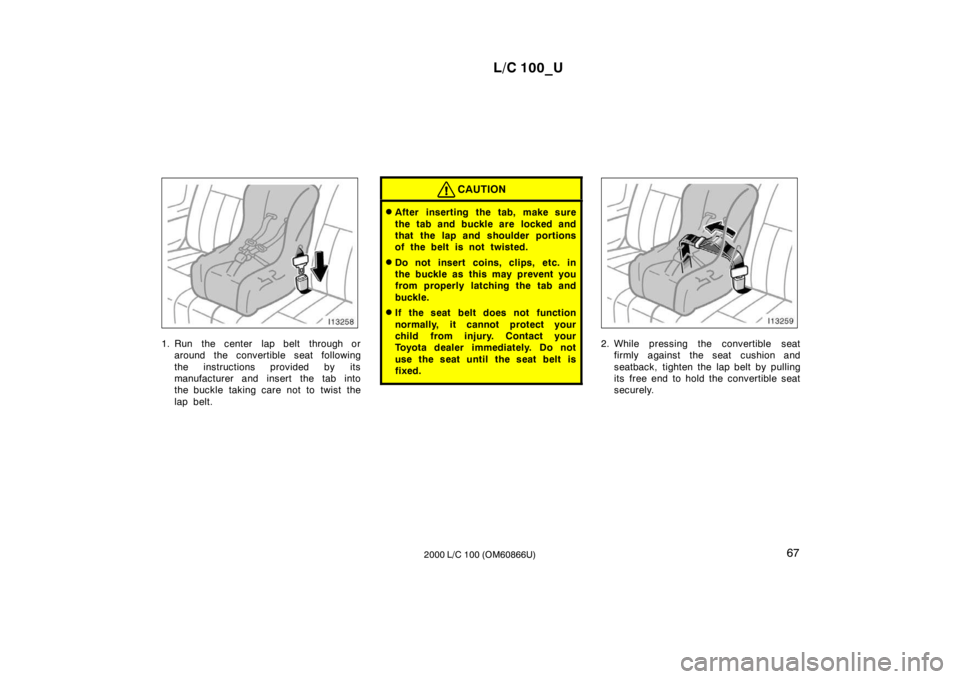child lock TOYOTA LAND CRUISER 2000 Owners Manual
[x] Cancel search | Manufacturer: TOYOTA, Model Year: 2000, Model line: LAND CRUISER, Model: TOYOTA LAND CRUISER 2000Pages: 235, PDF Size: 5.13 MB
Page 22 of 235

L/C 100_U
44 2000 L/C 100 (OM60866U)
For your safety and comfort, adjust the
head restraint before driving.
To raise: Pull it up.
To lower: Push it down while pressing the
lock release button.
Front head restraint only—You can also
move the head restraint forward or back-
ward. If such adjustment is desired, pull
or push the head restraint.
Rear center head restraint—When an oc-
cupant sits on the rear center seat, al-
ways pull up the rear center head re-
straint to the lock position.
The head restraint is most effective when
it is close to your head. Therefore, using
a cushion on the seatback is not recom-
mended.
CAUTION
�
Adjust the center of the head re-
straint so that it is closest to the
top of your ears.
� After adjusting the head restraint,
make sure it is locked in position.
� Do not drive with the head re-
straints removed.
Seat heaters
Left side
front seat Right side
front seat
To turn on the seat heater, push the
switch to ”HI” (high heating tempera-
ture) or ”LO” (low heating temperature).
The key must be in the ”ON” position.
Pushing lightly on the opposite side will
turn it off.
CAUTION
Occupants must use caution when op-
erating the seat heater because it
may make them feel too hot or cause
burns at low temperatures (erythema,
varicella). Use extra caution for; � Babies, small children, elderly per-
sons, sick persons or handicapped
persons
� Persons who have delicate skin
� Persons who are exhausted
� Persons who have taken alcohol or
drugs which induce sleep (sleeping
drug, cold remedy, etc.)
To prevent the seat from overheating,
do not use the seat heater with a
blanket, cushion, or other insulating
objects which cover the seat.
Page 24 of 235

L/C 100_U
46 2000 L/C 100 (OM60866U)
CAUTION
Persons should ride in their seats
properly wearing their seat belts
whenever the vehicle is moving.
Otherwise, they are much more likely
to suffer serious bodily injury or
death in the event of sudden braking
or a collision.
When using the seat belts, observe
the following: �Use the belt for only one person at
a time. Do not use a single belt for
two or more people—even children.
� Avoid reclining the seatbacks too
much. The seat belts provide maxi-
mum protection when the seatbacks
are in the upright position. (Refer
to the seat adjustment instructions.)
� Be careful not to damage the belt
webbing or hardware. Take care that
they do not get caught or pinched
in the seat or doors.
� Inspect the belt system periodically.
Check for cuts, fraying, and loose
parts. Damaged parts should be re-
placed. Do not disassemble or
modify the system.
�Keep the belts clean and dry. If
they need cleaning, use a mild soap
solution or lukewarm water. Never
use bleach, dye, or abrasive clean-
ers—they may severely weaken the
belts. (See ”Cleaning the interior”
in Section 5.)
� Replace the belt assembly (includ-
ing bolts) if it has been used in a
severe impact. The entire assembly
should be replaced even if damage
is not obvious.
Adjust the seat as needed and sit up
straight and well back in the seat. To
fasten your belt, pull it out of the re-
tractor and insert the tab into the
buckle.
You will hear a click when the tab locks
into the buckle.
The seat belt length automatically adjusts
to your size and the seat position.
The retractor will lock the belt during a
sudden stop or on impact. It also may
lock if you lean forward too quickly. A
slow easy motion will allow the belt to
extend, and you can move around freely.—3
−point seat belts
Page 25 of 235

L/C 100_U47
2000 L/C 100 (OM60866U)
If the seat belt cannot be pulled out of the
retractor, firmly pull the belt and release
it. You will then be able to smoothly pull
the belt out of the retractor.
When a passenger ’s shoulder belt is com-
pletely extended and is then retracted
even slightly, the belt is locked in that
position and cannot be extended. This fea-
ture is used to hold the child restraint
system securely. (For details, see ”Child
restraint” in this section.) To free the belt
again, fully retract the belt and then pull
the belt out once more.
CAUTION
�
After inserting the tab, make sure
the tab and buckle are locked and
that the belt is not twisted.
� Do not insert coins, clips, etc. in
the buckle as this may prevent you
from properly latching the tab and
buckle.
� If the seat belt does not function
normally, immediately contact your
Toyota dealer. Do not use the seat
until the seat belt is fixed. It cannot
protect an adult occupant or your
child from injury.
Seat belts with an adjustable shoulder
anchor—
Adjust the shoulder anchor position to
your size.
To raise: Slide the anchor up.
To lower: Push in the lock release button
and slide the anchor down.
After adjustment, make sure the anchor is
locked in position.
CAUTION
Always make sure the shoulder belt
is positioned across the center of
your shoulder. The belt should be
kept away from your neck, but not
falling off your shoulder. Failure to
do so could reduce the amount of
protection in an accident and cause
serious injuries in a collision.
Page 27 of 235

L/C 100_U49
2000 L/C 100 (OM60866U)
—2
−point seat belt
Lengthen
Sit up straight and well back in the
seat. To fasten your belt, insert the tab
into the buckle.
You will hear a click when the tab locks
into the buckle.
If the belt is not long enough for you, hold
the tab at a right angle to the belt and
pull on the tab.
CAUTION
� After inserting the tab, make sure
the tab and buckle are locked and
that the lap and shoulder portions
of the belt is not twisted.
� Do not insert coins, clips, etc. in
the buckle as this may prevent you
from properly latching the tab and
buckle.
� If the seat belt does not function
normally, immediately contact your
Toyota dealer. Do not use the seat
until the seat belt is fixed. It cannot
protect an adult occupant or your
child from injury.
To o h i g h
Adjust to a snug fit
Keep as low on hips as possible
Remove excess length of the belt and
adjust the belt position.
To shorten the belt, pull the free end of
the belt.
Position the lap belt as low as possible
on your hips—not on your waist, then ad-
just it to a snug fit.
CAUTION
High −positioned and loose −fitting lap
belts could cause serious injuries due
to sliding under the lap belt during a
collision or other unintended result.
Keep the lap belt positioned as low
on hips as possible.
Page 29 of 235

L/C 100_U51
2000 L/C 100 (OM60866U)
To connect the extender to the seat
belt, insert the tab into the seat belt
buckle so that the ”PRESS” signs on
the buckle −release buttons of the ex-
tender and the seat belt are both facing
outward as shown.
You will hear a click when the tab locks
into the buckle.
When releasing the seat belt, press on
the buckle −release button on the extender,
not on the seat belt. This helps prevent
damage to the vehicle interior and extend-
er itself.
When not in use, remove the extender
and store in the vehicle for future use.
CAUTION
� After inserting the tab, make sure
the tab and buckle are locked and
that the lap and shoulder portions
of the belt is not twisted.
� Do not insert coins, clips, etc. in
the buckle as this may prevent you
from properly latching the tab and
buckle.
� If the seat belt does not function
normally, immediately contact your
Toyota dealer. Do not use the seat
until the seat belt is fixed. It cannot
protect an adult occupant or your
child from injury.
—Front seat belt pretensioners
The driver and front passenger ’s seat
belt pretensioners are designed to be
activated in response to a severe fron-
tal impact.
When the airbag sensor detects the shock
of a severe frontal impact, the front seat
belt is quickly drawn back in by the re-
tractor so that the belt snugly restrains
the front seat occupants.
The seat belt pretensioners are activated
even with no passenger in the front seat.
Collisions occurring at certain speeds and
angles may cause the seat belt preten-
sioners and SRS airbags not to operate
all together.
Page 42 of 235

L/C 100_U
64 2000 L/C 100 (OM60866U)
(A) INFANT SEAT INSTALLATION
An infant seat is used in rear−facing
position only.CAUTION
Do not put a rear −facing child re-
straint system on the third seat if it
interferes with the lock mechanism of
the second seats. This may cause se-
vere injury to the child and passen-
gers sitting in the second seats in
case of sudden braking or a co llision.
1. Run the center lap belt through or
around the infant seat following the
instructions provided by its manufactur-
er and insert the tab into the buckle
taking care not to twist the lap belt.
—Installation with 2
−point
type seat belt
Page 43 of 235

L/C 100_U65
2000 L/C 100 (OM60866U)
CAUTION
� After inserting the tab, make sure
the tab and buckle are locked and
that the lap and shoulder portions
of the belt is not twisted.
� Do not insert coins, clips, etc. in
the buckle as this may prevent you
from properly latching the tab and
buckle.
� If the seat belt does not function
normally, it cannot protect your
child from injury. Contact your
Toyota dealer immediately. Do not
use the seat until the seat belt is
fixed.
2. While pressing the infant seat firmly
against the seat cushion and seatback,
tighten the lap belt by pulling its free
end to hold the infant seat securely.CAUTION
Push and pull the child restraint sys-
tem in different directions to be sure
it is secure. Follow all the installation
instruction provided by its manufac-
turer.
Page 44 of 235

L/C 100_U
66 2000 L/C 100 (OM60866U)
3. To remove the infant seat, press the
buckle −release button.(B) CONVERTIBLE SEAT INSTALLATION
A convertible seat is used in forward −
facing and rear −facing position depend-
ing on the child’s age and size. When
installing, follow the manufacturer’s
instruction about the applicable child’s
age and size as well as directions for
installing a child restraint system.CAUTION
Do not put a rear −facing child re-
straint system on the third seat if it
interferes with the lock mechanism of
the second seats. This can cause se-
vere injury to the child and passen-
gers sitting second seats in case of
sudden braking or a co llision.
Page 45 of 235

L/C 100_U67
2000 L/C 100 (OM60866U)
1. Run the center lap belt through or
around the convertible seat following
the instructions provided by its
manufacturer and insert the tab into
the buckle taking care not to twist the
lap belt.
CAUTION
�After inserting the tab, make sure
the tab and buckle are locked and
that the lap and shoulder portions
of the belt is not twisted.
� Do not insert coins, clips, etc. in
the buckle as this may prevent you
from properly latching the tab and
buckle.
� If the seat belt does not function
normally, it cannot protect your
child from injury. Contact your
Toyota dealer immediately. Do not
use the seat until the seat belt is
fixed.
2. While pressing the convertible seat
firmly against the seat cushion and
seatback, tighten the lap belt by pulling
its free end to hold the convertible seat
securely.
Page 47 of 235

L/C 100_U69
2000 L/C 100 (OM60866U)
CAUTION
� Never put a rear −facing child re-
straint system on the front seat be-
cause the force of the rapid infla-
tion of the passenger airbag can
cause death or serious injury to the
child.
� Do not put a rear −facing child re-
straint system on the second (or
third) seat if it interferes with the
lock mechanism of the front (or se-
cond) seats. This may cause severe
injury to the child and front passen-
ger in case of sudden braking or a
collision.1. Run the lap and shoulder belt through or around the infant seat following the
instructions provided by its manufactur-
er and insert the tab into the buckle
taking care not to twist the belt. Keep
the lap portion of the belt tight.